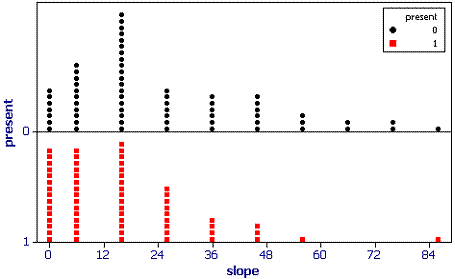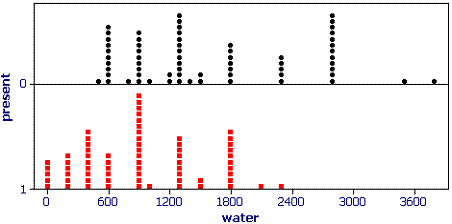Preliminaries
The aim of the exercise is to predict whether some mountain sheep are likely to be found at particular locations and which variables are implicated in their presence/absence. There are four potential predictors and one class variable.
Predictors
Vegetation: a measure of plant density (continuous variable)
Slope: slope of the land (degrees, continuous variable)
Water: distance to water (m, continuous variable)
Aspect: aspect of the land surface (a categorical variable), where 1 = E-NE, 2 = S-SE, 3 = W-SW and 4 = N-NW.
Class
Present (1 = sheep present, 0 = sheep absent)
Basic descriptive statistics
Variable present N Mean SE Mean Minimum Median Maximum
vegetation 0 123 4.920 0.714 0.0000 0.600 45.400
1 127 4.977 0.631 0.0000 1.400 31.400
slope 0 123 23.82 1.89 0.0000 15.00 85.00
1 127 14.69 1.42 0.0000 15.00 85.00
water 0 123 1543.8 72.0 500.0 1250.0 3795.0
1 127 869.3 50.2 25.0 875.0 2250.0
1 |
Aspect descriptive statisticsWhy have no descriptive statistics been presented for the aspect predictor? |
2 |
The best predictorWhich of the above seems to offer the greatest promise for discriminating between sheep locations? |
The following table shows the frequencies for each aspect in locations with and without the sheep.
Rows: aspect Columns: present Aspect 0 1 All 1 6 23 29 2 22 8 30 3 21 23 44 4 74 73 147 All 123 127 250
3 |
Aspect as a predictorDoes the aspect variable have any merit as a predictor of sheep presence? |
4 |
Predictor dot plotsExamine the dot plots below (each dot is two cases). After examining these which variable do you think is likely to be the best predictor of sheep presence. 


|